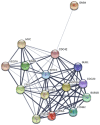Identification of hub genes and pathways in glioblastoma by bioinformatics analysis
- PMID: 30655863
- PMCID: PMC6312941
- DOI: 10.3892/ol.2018.9644
Identification of hub genes and pathways in glioblastoma by bioinformatics analysis
Abstract
Glioblastoma (GBM) is the most common type of malignant brain tumor, and is associated with poor patient prognosis. A comprehensive understanding of the molecular mechanism underlying GBM may help to guide the identification of novel diagnoses and treatment targets. The gene expression profile of the GSE4290 GBM dataset was analyzed in order to identify differentially expressed genes (DEGs). Enriched pathways were identified through Gene Ontology and the Kyoto Encyclopedia of Genes and Genomes analyses. A protein-protein interaction network was constructed in order to identify hub genes and for module analysis. Expression and survival analyses were conducted in order to screen and validate critical genes. A total of 1,801 DEGs were recorded, including 620 upregulated and 1,181 downregulated genes. Upregulated DEGs were enriched in the terms 'mitotic cell cycle process', 'mitotic cell cycle' and 'cell cycle process'. Downregulated genes were enriched in 'transsynaptic signaling', 'anterograde transsynaptic signaling' and 'synaptic signaling'. A total of 15 hub genes, which displayed a high degree of connectivity, were selected. These genes included vascular endothelial growth factor A, cyclin-dependent kinase 1 (CDK1), cell-division cycle protein 20 (CDC20), aurora kinase A (AURKA), and budding uninhibited by benzimidazoles 1 (BUB1). The identified DEGs and hub genes may help guide investigations on the mechanisms underlying the development and progression of GBM. CDK1, CDC20, AURKA and BUB1, which are involved in cell cycle pathways, may be potential targets in the diagnosis and therapy of GBM.
Keywords: bioinformatics analysis; glioblastoma; module analysis; pathway analysis; protein-protein interaction.
Figures



Similar articles
-
Identification of candidate biomarkers and pathways associated with SCLC by bioinformatics analysis.Mol Med Rep. 2018 Aug;18(2):1538-1550. doi: 10.3892/mmr.2018.9095. Epub 2018 May 29. Mol Med Rep. 2018. PMID: 29845250 Free PMC article.
-
Identification of potential crucial genes and molecular mechanisms in glioblastoma multiforme by bioinformatics analysis.Mol Med Rep. 2020 Aug;22(2):859-869. doi: 10.3892/mmr.2020.11160. Epub 2020 May 20. Mol Med Rep. 2020. PMID: 32467990 Free PMC article.
-
Bioinformatics analyses of significant genes, related pathways and candidate prognostic biomarkers in glioblastoma.Mol Med Rep. 2018 Nov;18(5):4185-4196. doi: 10.3892/mmr.2018.9411. Epub 2018 Aug 21. Mol Med Rep. 2018. PMID: 30132538 Free PMC article.
-
Hub genes and key pathways of non-small lung cancer identified using bioinformatics.Oncol Lett. 2018 Aug;16(2):2344-2354. doi: 10.3892/ol.2018.8882. Epub 2018 Jun 4. Oncol Lett. 2018. PMID: 30008938 Free PMC article.
-
Identification of key genes and pathways for esophageal squamous cell carcinoma by bioinformatics analysis.Exp Ther Med. 2018 Aug;16(2):1121-1130. doi: 10.3892/etm.2018.6316. Epub 2018 Jun 15. Exp Ther Med. 2018. PMID: 30112053 Free PMC article.
Cited by
-
Scouting for common genes in the heterogenous hypoxic tumor microenvironment and their validation in glioblastoma.3 Biotech. 2021 Oct;11(10):451. doi: 10.1007/s13205-021-02987-2. Epub 2021 Sep 26. 3 Biotech. 2021. PMID: 34631352 Free PMC article.
-
Identification of potential biomarkers and candidate small molecule drugs in glioblastoma.Cancer Cell Int. 2020 Aug 28;20:419. doi: 10.1186/s12935-020-01515-1. eCollection 2020. Cancer Cell Int. 2020. PMID: 32874133 Free PMC article.
-
Identification of CXCL8, IL1A, and IL1B as Hub Genes of Therapeutic Resistance in Glioblastoma Multiforme via Bioinformatics Analysis.Cancer Genomics Proteomics. 2025 Sep-Oct;22(5):791-808. doi: 10.21873/cgp.20537. Cancer Genomics Proteomics. 2025. PMID: 40883024 Free PMC article.
-
IL7 and IL7 Flt3L co-expressing CAR T cells improve therapeutic efficacy in mouse EGFRvIII heterogeneous glioblastoma.Front Immunol. 2023 Feb 3;14:1085547. doi: 10.3389/fimmu.2023.1085547. eCollection 2023. Front Immunol. 2023. PMID: 36817432 Free PMC article.
-
SOCS3 is Related to Cell Proliferation in Neuronal Tissue: An Integrated Analysis of Bioinformatics and Experiments.Front Genet. 2021 Sep 27;12:743786. doi: 10.3389/fgene.2021.743786. eCollection 2021. Front Genet. 2021. PMID: 34646310 Free PMC article.
References
LinkOut - more resources
Full Text Sources
Miscellaneous
